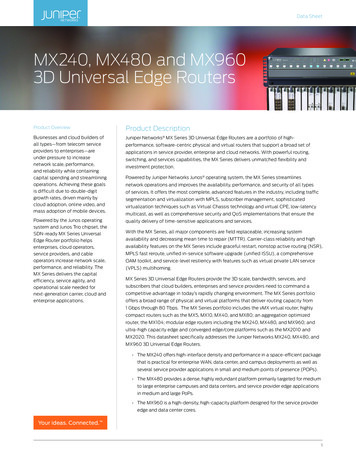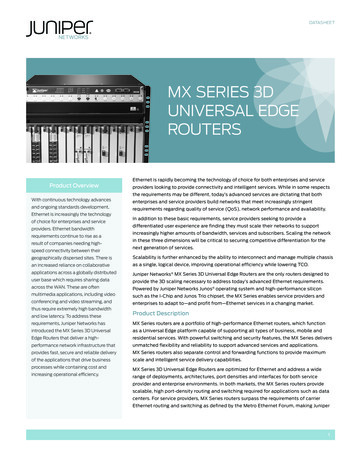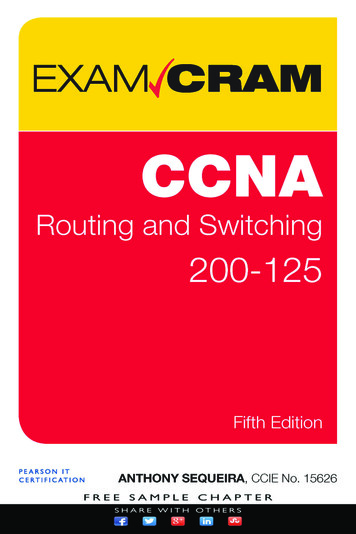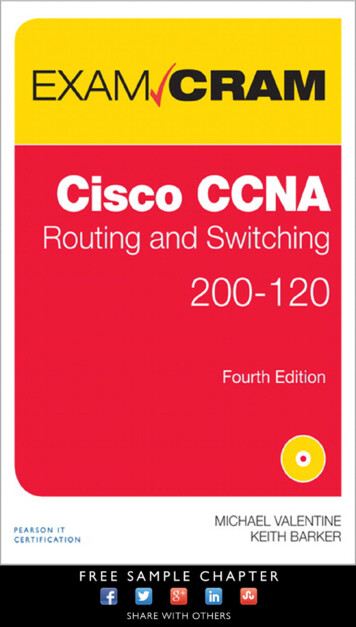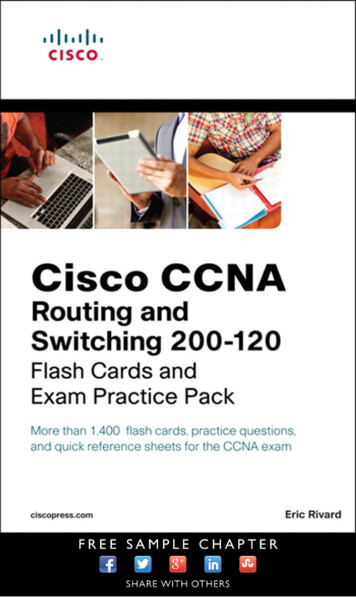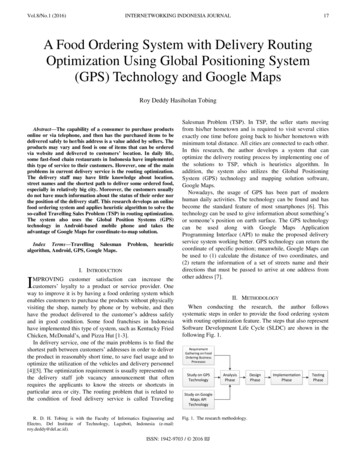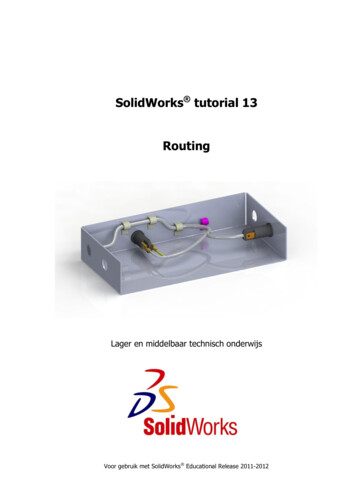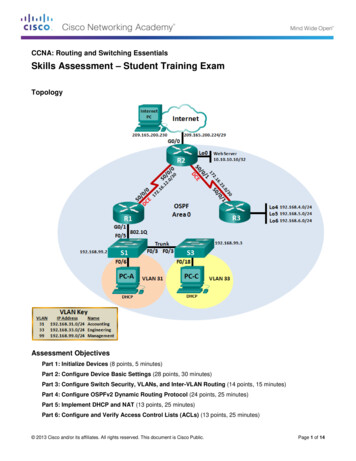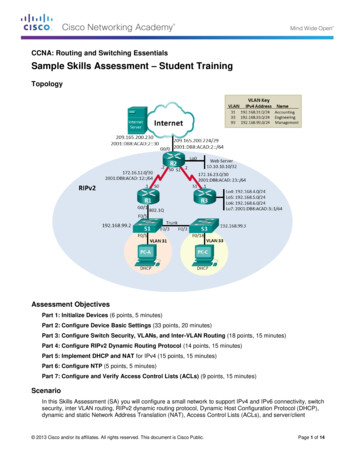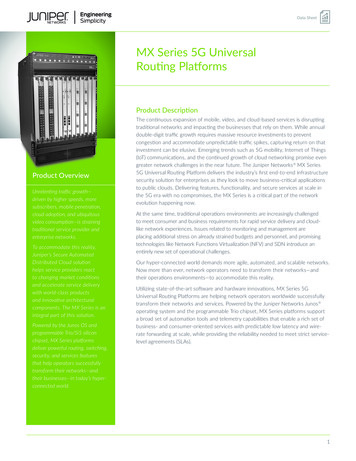
Transcription
Data SheetMX Series 5G UniversalRouting PlatformsProduct DescriptionProduct OverviewUnrelenting traffic growth—driven by higher speeds, moresubscribers, mobile penetration,cloud adoption, and ubiquitousvideo consumption—is strainingtraditional service provider andenterprise networks.To accommodate this reality,Juniper’s Secure AutomatedDistributed Cloud solutionhelps service providers reactto changing market conditionsand accelerate service deliverywith world-class productsand innovative architecturalcomponents. The MX Series is anintegral part of this solution.Powered by the Junos OS andprogrammable Trio/Si5 siliconchipset, MX Series platformsdeliver powerful routing, switching,security, and services featuresthat help operators successfullytransform their networks—andtheir businesses—in today’s hyperconnected world.The continuous expansion of mobile, video, and cloud-based services is disruptingtraditional networks and impacting the businesses that rely on them. While annualdouble-digit traffic growth requires massive resource investments to preventcongestion and accommodate unpredictable traffic spikes, capturing return on thatinvestment can be elusive. Emerging trends such as 5G mobility, Internet of Things(IoT) communications, and the continued growth of cloud networking promise evengreater network challenges in the near future. The Juniper Networks MX Series5G Universal Routing Platform delivers the industry’s first end-to-end infrastructuresecurity solution for enterprises as they look to move business-critical applicationsto public clouds. Delivering features, functionality, and secure services at scale inthe 5G era with no compromises, the MX Series is a critical part of the networkevolution happening now.At the same time, traditional operations environments are increasingly challengedto meet consumer and business requirements for rapid service delivery and cloudlike network experiences. Issues related to monitoring and management areplacing additional stress on already strained budgets and personnel, and promisingtechnologies like Network Functions Virtualization (NFV) and SDN introduce anentirely new set of operational challenges.Our hyper-connected world demands more agile, automated, and scalable networks.Now more than ever, network operators need to transform their networks—andtheir operations environments—to accommodate this reality.Utilizing state-of-the-art software and hardware innovations, MX Series 5GUniversal Routing Platforms are helping network operators worldwide successfullytransform their networks and services. Powered by the Juniper Networks Junos operating system and the programmable Trio chipset, MX Series platforms supporta broad set of automation tools and telemetry capabilities that enable a rich set ofbusiness- and consumer-oriented services with predictable low latency and wirerate forwarding at scale, while providing the reliability needed to meet strict servicelevel agreements (SLAs).1
MX Series 5G Universal Routing PlatformsAn Agile Family of Cloud-Era UniversalRouting PlatformsThe MX Series portfolio was designed for agility and built fromthe ground up to support a universal set of edge applications,helping Juniper customers rapidly respond to evolving businessand technical requirements while simplifying operations withoutsacrificing their current infrastructure investments.With its massive scale and efficiency, the MX Series is ideal forspace- and power-constrained environments. It redefines perslot economics, enabling customers to do more with less whilesimplifying network design, reducing OpEx. It also enables theprofitable delivery of a broad range of business, residential,mobile, cable, data center, and cloud services while seamlesslysupporting traditional and emerging network architectureswith adaptive software and pervasive security. The flexibilityof the MX Series is enabled by the programmable Trio chipset,which allows MX Series platforms to add support for newfeatures, such as telemetry, without costly hardware upgrades.Additionally, support for the Junos Automation Toolkit andthe Juniper Extension Toolkit provide modern programminglanguages that reduce costs and increase profitability byimproving productivity and customization.This agility is evident in the wide variety of MX Series usecases that have been proven in the world’s largest and mostdemanding networks, including: Business Edge: MX Series platforms support the broadestrange of L2/L2.5/L3 VPN services which, in combinationwith multilayer, multiprotocol resiliency, ensure thatcustomer SLAs are met under all network conditions. Internet/Peering Gateway: MX Series platforms supportthe high performance, reliability, scale, and density neededto efficiently peer with Internet and other service providernetworks. Broadband Network Gateway (BNG): MX Series platformsoffer the highest subscriber density and most sophisticatedbroadband edge features available in the industry. Universal SDN Gateway: The MX Series offers acomprehensive solution for interconnecting virtualand physical networks—as well as between virtualnetworks operating with different technologies—viasupport for Multiprotocol BGP (MBGP), dynamic tunnelsusing MPLSoGRE or Virtual Extensible LAN (VXLAN)encapsulation, virtual routing and forwarding (VRF) tables,E-VPNs, and Network Configuration Protocol (NETCONF),along with the ability to send traffic between VRF and globalrouting tables based on configuration and policy. Data Center and Cloud Edge: The MX Series is idealfor data center/cloud edge applications, with supportfor multiple overlay encapsulation methods, includingVXLAN, Network Virtualization using Generic RoutingEncapsulation (NVGRE), MPLSoUDP, MPLSoGRE,802.1BR, SR-MPLS, and SR-V6. The MX Series alsoincorporates data plane security with inline IPsec/MACsecin the MPC-10E line cards, making it a perfect fit for datacenter and cloud deployments. Enterprise WAN: Enterprises and government agenciesworldwide use MX Series platforms to build their ownoverlay network on top of a service provider’s Layer 2 orMPLS network, using encapsulation technologies such asMPLSoGRE, VXLAN, and IPsec for secure transport. Universal Metro/Aggregation: MX Series platforms offera full suite of routing and switching features, allowing youto choose a deployment model that best fits your businessand technical needs. The MX Series can be deployed asIP/IP VPN edge routers, Ethernet VPN (EVPN) and virtualprivate LAN service (VPLS) provider edge (VPLS-PE) routers,MPLS label-switching (LSR) routers, and as Layer 2 Ethernetswitches or Layer 3 IP routers. Mobile Backhaul: In addition to switching, routing, andsecurity features, MX Series platforms support highlyscalable and reliable hardware-based timing that meets thestrictest LTE requirements, including Synchronous Ethernetfor frequency and the Precision Time Protocol (PTP) forfrequency and phase synchronization. In addition, theMX104 is ETSI 300-compliant, enabling deployment in nextgeneration mobile applications such as 5G.At-a-Glance: MX Series 5G UniversalRouting Platforms ComparisonThe MX Series portfolio includes a wide range of physical andvirtual platforms that share a common architecture and featureset. This enables Juniper customers to select the platform thatbest addresses their unique business goals and satisfies theirscale, density, resiliency, space, power, and value-added servicerequirements without compromising on quality or features.Modular MX Series PlatformsMX960, MX480, and MX240 5G Universal Routing Platformsare modular, chassis-based platforms. The MX960 has been proven in the world’s largest serviceprovider, cable, mobile, and data center networks, offering12 Tbps of system capacity in support of business andresidential broadband services as well as peering andprovider edge applications.2
MX Series 5G Universal Routing Platforms The MX480 is a modular, 9 Tbps-capable routerthat supports a wide range of cloud, campus, enterprise,data center, service provider, cable, and mobile servicecore applications. The MX240 is a compact, 3 Tbps-capable router ideal forspace-constrained cloud, enterprise, data center, serviceprovider, cable, and mobile service core deployments.The latest generation of line card hardware for the MX960,MX480, and MX240 platforms delivers multi-terabit cryptocapabilities with 256-bit encryption complying with AESGCM encapsulation per RFC4303; AES-GCM encapsulationper RFC4106; AES-GMAC encapsulation per RFC4543; andAES-GMAC (IPv4/v6) encapsulation per RFCs 4302 and 4543.Along with multi-terabit routing, the latest MPC also deliversintegrated Layer 2 MACsec features at flexible interface rates of10GbE, 40GbE, and 100GbE.Fixed-Configuration MX Series PlatformsMX204, MX150, MX104, MX80, MX40, MX10, and MX5Universal Routing Platforms are fixed-configuration platformsthat support modular interfaces. The MX204 is a space- and power-optimized routerdelivering ultra-high port density and throughput whileconsuming just 0.9 W/Gb. It addresses the emerging edgeand metro Ethernet networking needs of service providers,mobile, web-scale operators, and MSOs by delivering 400Gbps of throughput in support of high-density 100GbE,40GbE, and discrete and breakout 10GbE and 1GbEinterfaces—all in a single rack unit. The MX150 is a compact, full-featured router delivering20 Gbps of throughput in support of 1GbE and 10GbEinterfaces. It provides a cost-effective solution for a widerange of low-bandwidth provider edge, business edge,broadband network gateway (BNG), and enterprise WANapplications. The MX104 is a mobile backhaul-optimized, ETSI 300mm-compliant chassis with high redundancy and 80 Gbpsof throughput. The MX104 offers four MIC slots andredundant fixed 10GbE interfaces for flexible networkconnectivity. The MX80, MX40, MX10, and MX5 are softwareupgradeable from 20 Gbps to 80 Gbps, enabling costeffective “pay as you grow” scale. These platforms have upto four Modular Interface Card (MIC) slots and two fixed10GbE interfaces for connecting to the network.The following table provides a comparison between the variousMX Series modular and fixed-configuration platforms.Table 1: MX Series 5G Universal Routing Platforms at a 5Rack units1685113.52222Systems per rack36948481324242424Slots11 MPCs6 MPCs2 MPCs8 10GbE,4 100GbENA4 10GbE,4 MIC slots4 10GbE,31 MICslots2 10GbE,32 MICslots3 MICslots3 MICslotsPer slot capacity1.5 Tbps1.5 Tbps1.5 TbpsNANANANANANANAMaximum systemthroughput12 Tbps9 Tbps3 Tbps400 Gbps20 Gbps80 Gbps80 Gbps60 Gbps40 Gbps20 esNANAYesYesYesYesNAMaximum 1GbE48036012024128080604020Maximum 10GbE4803601202428841NAMaximum 40GbE12090304NANANANANANAMaximum 100GbE12090304NANANANANANAMaximum 400GbE24186NANANANANANANA10GbE DWDM884816NANANANANANANA100GbE DWDM22124NANANANANANANA34The MX80 has two front MIC slots and one rear MIC slot. The rear MIC slot only supports the MS-MIC.The MX40 has two front MIC slots and one rear MIC slot. The rear MIC slot only supports the MS-MIC.The MX10 has two front MIC slots and one rear MIC slot. The rear MIC slot only supports the MS-MIC.4The MX5 has one front MIC slot and one rear MIC slot. The rear MIC slot only supports the MS-MIC.1233
MX Series 5G Universal Routing PlatformsArchitecture and Key ComponentsTable 2: MPC-10E Line Card Benefits at a GlanceModular Components for Chassis-Based MX Series PlatformsAttributeBenefitThe modular, chassis-based MX960, MX480, and MX240 sharethe following components:PerformanceTriples MX960/MX480/MX240 chassis performance to1/1.5 Tbps per slot with new SCBE3 fabric, enabling up to10 Tbps throughputUniversalInterfacesReduces interface sparing with multi-rate 10/40/100GbEinterfacesPower EfficiencyConsumes 0.5 W per gigabit per system levelInline Data PlaneSecurityFeatures AES-256 MACsec line-side encryption andnative IPsec tunnel supportInvestmentProtectionBackward compatible with existing MPCs and REs: PC3E/MPC4E/MPC5E/MPC7E/NG-MPC, MS-MPC, NGMSMPC, MPC2E/3E-NG, and 16x10G MPCs; RE-S-1800and RE-S-X6 Routing Engine modulesSeamlessDeploymentReuse deployed MX960/MX480/MX240 chassis, powermodules, and fan trays Modular Port Concentrators (MPCs) provide routing, MPLS,switching, inline services, subscriber management, andhierarchical quality of service (HQoS) among many otherfeatures. MPCs may also host interfaces directly or viaModular Interface Cards (MICs) that allow users to “mix andmatch” interface types. Powered by the programmable Triochipset, MPCs collect and stream telemetry that identifiesresource utilization, loss and delay, and other metrics. Switch Control Boards (SCBs) feature an integratedswitch fabric that connects to all slots in the chassis in anonblocking architecture. The SCBs house the RoutingEngine, control power to MPCs, monitor and control systemfunctions such as fan speed and the system front panel, andmanage clocking, resets, and boots. The Routing Engine (RE) provides the control plane, runsJuniper Networks Junos operating system, and handlesall routing protocol processes as well as the softwareprocesses that control MPCs, chassis components,system management, and user access to the router. REscommunicate with MPCs via dedicated out-of-bandmanagement channels.MPC-10E Line CardThe MPC-10E line card is a key contributor to the serviceprovider transformation in the cloud era when deployed withMX960, MX480, and MX240 platforms in a Juniper SecureAutomated Distributed Cloud environment. By providing theunderlying network infrastructure with scale, agility, routinginnovation, and pervasive security while incorporating universal(10/40/100/400GbE) ports, the MPC-10E protects existinginvestments with disaggregated software innovation andinfinite programmability. Built-in automation enables rapiddeployment without disrupting the existing MX960/MX480/MX240 footprint. The MPC-10E line card is powered by thenew Juniper
The Juniper Networks . MX960, MX480, and MX240 5G Universal Routing Platforms are modular, chassis-based platforms. The MX960 has been proven in the world’s
